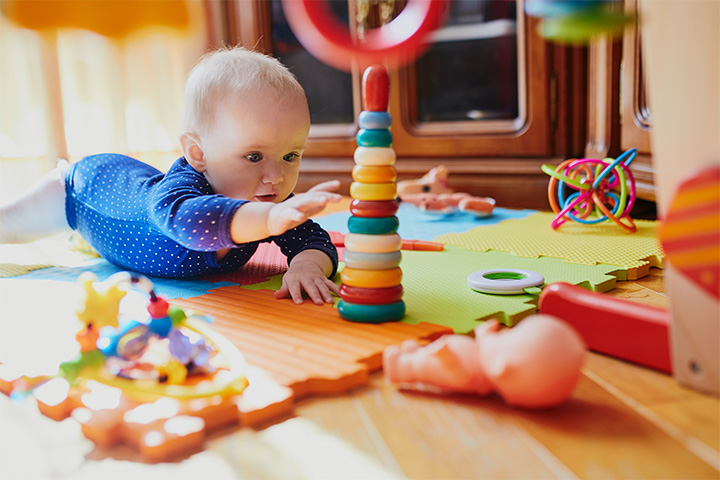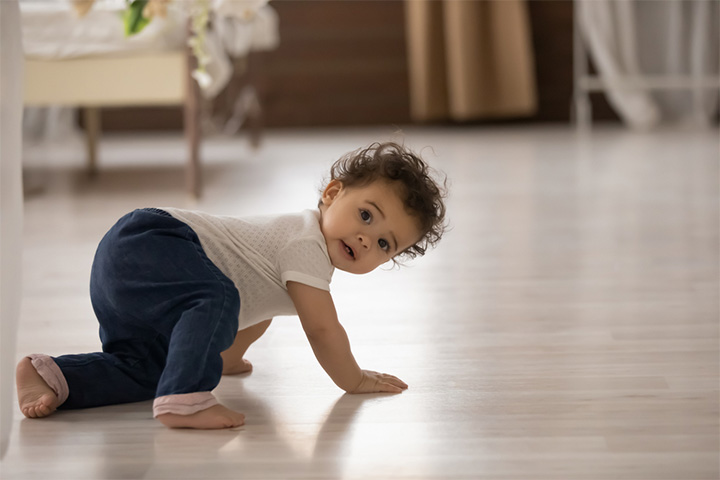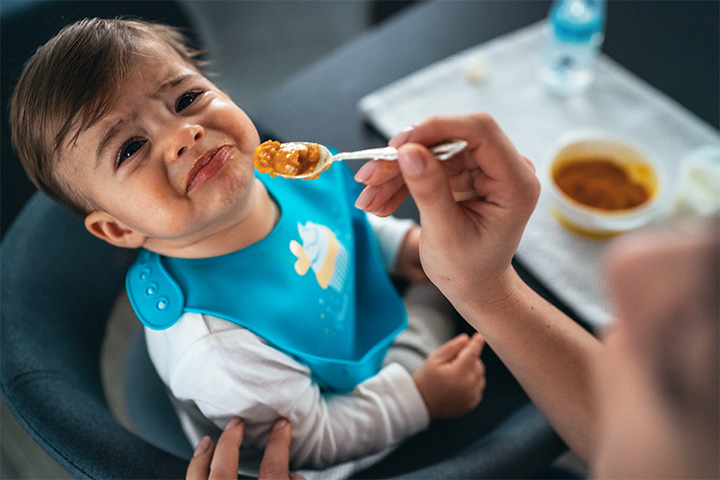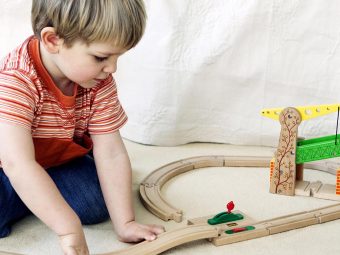
Image: Shutterstock
Roll, crawl, scoot, and wriggle are techniques that babies adopt to move. You may see your baby scooting before they begin crawling. Scooting is an adorable way that many babies use when they start moving independently.
Some babies may try scooting along with crawling, or these two movements could occur independently.It is also common for some babies to continue scooting until they pull themselves up to try walking. But is it normal for babies to scoot? How to help your baby crawl instead of scoot?
Read on to find answers to these questions and more on baby scooting.
What Is Scooting?
快移动技术,一个孩子可能use to move around unassisted(1). It is an alternative to traditional crawling. Unlike standard crawling styles, scooting does not always employ both hands and legs. Some infants combine different styles of movements(2).
There are different types of scooting.
- Bottom scooting: Babies sit on their bottoms and slide or wriggle from forward or backward with the help of their arms.
- Sideways scooting: It is also called a crab crawl. Infants move sideways, push their bodies with their hands, and dart like a crab.
- 腹部爬行:This style involves the baby scooting on the belly.Babies lie on their stomachs, with feet on the floor, and advance forward using their arms.They drag their tummy across the ground while moving forward or backward. It is also called a commando crawl.
Image: IStock
- Rolling: Babies who use this technique move around to different locations by rolling around the floor. They use their hands to push and move their body.
 Be watchful
Be watchfulWhen Do Babies Start Scooting?
Scooting may often occur around the time when the baby begins crawling. A baby may begin crawling as early as six months and may display scooting at this age(3). Most babies display scooting between the ages of eight and 12 months, with the average age being nine months(4).
Image: Shutterstock
Initially, the baby may sway or rock forward and backward on their hands and knees(5). They might even propel themselves in a direction due to greater strength in their arm muscles. The baby will gradually learn to scoot through trial and error and practice.
Is Scooting Bad For Babies?
Scooting is a normal form of movement and not bad for babies. Some infants may entirely rely on alternative methods of movement, such as scooting.According to the American Academy of Pediatrics, as long as the baby can coordinate their body movements and uses all their limbs equally, there is no need to be worried(6).
How Long Do Babies Scoot Before They Crawl?
Most babies switch to crawling within weeks of starting scooting. Some babies may crawl later but do so within eight to 12 months of age. A few babies may alternate between scooting and crawling, while some may not crawl at all. Skipping crawling and relying entirely on scooting is a normal event as long as the baby is achieving otherdevelopmental milestonesiXStages of a baby’s development in which they attain vital life skills as they grow.on time.
Image: Shutterstock
When To Be Concerned?
Scooting is seldom a cause for concern. However, you may consult a doctor in the following scenarios.
- Some experts note that babies who prefer scooting and skip crawling may not support their body weight on their legs readily(7). They may fold their legs at their knees when held in a standing position. It may cause them to walk later than usual eventually. See a doctor if the baby does not stand when supported at 12 months and does not walk by 18 months(8).
- The baby shows poor coordination between limbs and awkward body movements while scooting or crawling.
 Point to consider
Point to consider- The baby only prefers scooting and haslow muscle tone(hypotonia), and seems floppy while moving or when held. In rare cases, it could be indicative of an underlyingneuromuscular disorderiXA condition that affects the muscles and nerves, leading to muscular pain, numbness, and weakness.(9).
- You suspect or observe other physical, cognitive, or speech-relateddevelopmental delaysiXA delay in the typical physical, emotional, or mental growth or development of a child.in babies.
- If your child is not eating well and iscachexiciXA condition characterized by substantial weight loss and muscle wasting as a result of an illness or a chronic disease..
Image: IStock
- Anytype of seizuresin the past.
Precautions To Take When Baby Scoots
婴儿是谁快在地板上常在hurry to explore their surroundings. It might lead to mishaps if you do not baby-proof your house. Here are a few precautions to prevent accidents when your baby scoots(10).
- Invest in safety latches and locks:Cabinets and drawers across the house should have safety latches and locks. It can prevent access to potentially harmful substances, such as detergents, cleaners, cosmetics, bleach, or medicines. Kitchen items, such as glassware, sharp objects, or matchsticks, should also be stored locked away from the scooting baby.
- Use doorknob covers and door locks:Door locks are important to deter babies from entering rooms or areas where they can be injured. The locks must be child-proof.Doorknob covers prevent babies from opening doors to potentially risky areas, such as bathrooms, or getting locked in accidentally.
- Secure appliances and furniture:Babies tend to climb over furniture or reach out for appliances placed on furniture. Unattached furniture and appliances, such as television sets, bookcases, or dressers, may tumble down. Anchor such objects to the wall or the floor to prevent them from tipping over. Anti-tip brackets can be used to secure freestanding objects.
- Install window grills:Add window grills or bars to windows and balconies. The installation should be secure, and the gap between the bars should not be more than four inches. Maintain an escape route in every room in case of fire.
- Restrict access to the pool:If you have a pool, install a pool fence around it. Make sure the fence is sturdy enough not to fall even if thebaby stands holdingto it.
- Use cordless window coverings:Window cords can be hazardous for babies who scoot and explore the house. Use cordless window coverings or tuck the cords away beyond the baby’s reach.
- Remove sharp-edged furniture or cover it:A scooting baby might bang against sharp-edged furniture, leading to injuries. Keep sharp-edged furniture away or cover the edges with protective padding.
- Cover electrical sockets:Babies may touch or insert fingers into electrical sockets. Therefore, use outlet covers or plates to avoid any mishaps.
- Install safety gates:Install safety gates at potentially risky places, such as before a flight of stairs. Make sure you pick gates that meet high safety standards.
 Caution
CautionHow To Help Baby Go From Scooting To Crawling?
Parents may try the following tactics and measures to condition the baby’s body for crawling. These methods may encourage the baby to prefer crawling over scooting eventually(5)(6).
- Initiate tummy time:Put down your baby on the tummy regularly. Tummy time improves ababy’s motor skillsand helps strengthen their back and neck muscles, preparing their body for crawling.
- Entice them with interesting toys:Place toys on either side of the baby duringtummy time. It will encourage the little one to twist and reach out for the toys. Twisting could help thebaby exerciseweight transfer and improve their body balance.
- Set some obstacles on their way:Place simple obstacles, such as pillows or boxes, to encourage the baby to try alternative ways of movement. For instance, a scooting baby may have to get down on all fours to crawl over the obstacles. A toy or a parent at the other end of the obstacle course could encourage the baby.
Image: Shutterstock
- Hold them horizontal to the ground:Hold the baby face down and horizontal to the ground such that your hands support their torso. Gently move the baby closer to the floor. It will encourage the baby to extend their hands and legs and touch the ground. As your baby gets better at it, you can leave your support, causing the baby to support their torso on their four limbs. It makes for an excellent precursor to crawling.
- Show them how to crawl:Some babies may be motivated to perform an action if they see their parents doing it. You can get on all fours and crawl around your baby while encouraging them to do the same.
Frequently Asked Questions
1. What causes babies to scoot instead of crawl?
Some babies may not crawl but choose other ways to move around, such as scooting and creeping (11).
2. Why is my baby scooting backward on their back?
If your baby is scooting backward initially, it’s completely normal when they are trying to move. Also, for some babies, a backward scoot could be a prelude for their first forward movement (5).
3. What if your baby doesn’t scoot?
It is normal for babies not to scoot. Also, the type of movements seen in babies varies greatly. While some choose to scoot or scoot and then crawl, others may not scoot but begin crawling, followed by walking (7).
Scooting is a standard form of movement and is not bad for babies. Baby scooting is a way to get around when they start moving independently. It’s a prelude to traditional crawling for some babies, but others prefer scooting to get around and stick with it until they’re ready to start pulling up and walking. Most babies switch to crawling within weeks of starting scooting. Those who prefer to hurry rather than crawl may find it challenging to sustain their body weight on their legs. It is best to see a doctor if the baby does not stand when supported at 12 months, does not walk by 18 months, shows poor coordination between the limbs, and has low muscle tone. Also, take adequate precautions to avoid mishaps while the baby is in a hurry to explore the surroundings by scooting.
Infographic: Precautions To Take When Baby Scoots
When your baby starts moving on their own, you must take necessary measures to keep them safe and avoid mishaps. This infographic details some crucial home safety measures to follow when your baby starts scooting.

Illustration: Momjunction Design Team
Get high-quality PDF version by clicking below.
Download Infographic
Key Pointers
- Scooting is a baby’s independent movement skill that does not necessarily require the use of hands and legs.
- Different forms of scooting in babies include bottom scooting, sideways scooting, belly crawling, and rolling.
- Most babies start scooting between 8-12 months of age.
- Babies who prefer to scoot rather than crawl may find it difficult to sustain their body weight on their legs.
- When your infant scoots, you should take adequate precautions to avoid mishaps.
References:
2. Susan K. Patrick, J. Adam Noah, and Jaynie F. Yang,Developmental constraints of quadrupedal coordination across crawling styles in human infants;U.S. National Library of Medicine
3.Infant – newborn development;U.S. National Library of Medicine
4. Amanda Morin,Developmental milestones from birth to age 1;Understood
5.Steps Toward Crawling;Zero to Three
6.Movement: Babies 8 to 12 Months;American Academy of Pediatrics
7.Bottom shuffling babies;NHS
8.Milestone Moments;CDC
9. Delyth Howard,Child development and developmental problems;Elsevier
10.Childproofing Your Home- 12 Safety Devices To Protect Your Children;U.S. Consumer Product Safety Commission
11.Movement, Coordination, and Your 8- to 12-Month-Old; Cook Children’s Health Care System





















